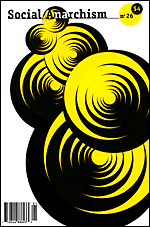Art & Society
Dear Social Anarchism,
Thank you for your card reminding me that I owe you a review of Art & Society: Lectures and Essays by William Morris, edited by Gary Zabel. I regret that I cannot bring myself to seriously review the book and I will be happy to return it to you.
I read it and that was torture. I had been curious about Morris, being somewhat acquainted with some of his design work, and more about what he had to say about art and political work.
There were seven or eight entries in the book. One would have sufficed. They essentially repeated a few points. The one point I liked was that the objects of life, of a home, and of a place of work should be simultaneously functional and beautiful. There should be no separation between that which is made, and the maker. Marx, Bakunin, and many others have, of course, made the same point.
Morris's writings were directed at the "priveleged" and his call was to them, to put aside selfishness and greed, and share their wealth and education with all classes. It was clear to him that without an active noblesse oblige, an era of barbarism was upon us, through horrid conditions, and most certainly through bad design and ugliness. He called for a compassionate elite to implement socialism in a spirit of beauty and joy.
Morris made frequent references to capitalism as "anarchy"! I was amused to think that if anarchists read him closely, many would be offended by this. He is often included in the anarchist pantheon. I think from these essays that he thought little of anarchism, to call an evil force, capitalism, by that name.
Of course maybe he knew something we don't. Anarchists tend to be very effective in their critiques of state socialism, and less in those of capitalism. Of late, more and more, I have wondered if there isn't a secret admiration of capital and its inherent anarchism, among anarchists. Nothing gets up the hair on our backs like the mention of a socialist, though. Beware Gennady Zuganov!
Morris cited past societies as examples of better societies, especially Medieval, with guilds, aristocrats, harmony within social arrangements, and with nature. These allusions were not convincing. In fact, I doubt that it is ever useful, when trying to construct an image of a good society, to look to the past. First, we don't know, second, that then becomes the focus for debate, third, we must imagine from what we have now and what we don't have. But that's a demanding project.
I learned nothing new about the transaction between art or artists and the movement for a just society. Morris was well-intentioned and his anger at his own class was real. His prescription was to bring the academy to the daily lives of the poor and toiling classes. I am convinced at this point that the only significant example of a melding of art and revolutionary struggle exists in the early years of the Soviet era. But that cannot be for anarchist ears.
With best wishes,
Michael Bacon

